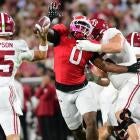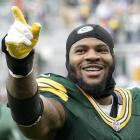What NFL scouts say about Colorado two-way star Travis Hunter, who will have to choose between WR and CB
Hunter could chip in at either position from time to time in the NFL, but scouts say there's no way his body would hold up playing 100 snaps over 17 games at the NFL level

Entering last week's game against Colorado, North Dakota State went in with a game-plan for Travis Hunter that the staff hoped would ultimately decrease the two-way star's effectiveness in at least one of his two roles.
It didn't work.
"Our offensive strategy was to make him stay busy when he played defense so that he wouldn't be as great on offense, but he wasn't phased by the activity," a North Dakota State staffer told CBS Sports. "His mindset and mentality is what makes him somewhat generational if that's the word for it."
Not only were Hunter's seven catches, 132 yards and three touchdown catches at wide receiver key in Colorado pulling out a 31-26 win but his play on offense was so impressive that it's led even more to a lack of consensus among NFL scouts regarding Hunter's best position fit at the NFL level.
For a while, most in the NFL personnel space seemed to view Hunter as a cornerback prospect who could also potentially help an NFL team in spot duty as a receiver. Now, for some, that thought process is starting to change.
"It will be interesting to see how it plays out and that will be a healthy discussion," an NFL personnel source told CBS Sports. "I know several scouts of that same opinion: better wide receiver prospect than cornerback. And when I watched him this summer, I was thinking receiver over corner."
This situation is a first of sorts. A longtime NFL personnel official couldn't remember another player with legitimate first-round talent like this as a both a cornerback as well as at wide receiver. The closest comparison he could think of was Hall of Fame cornerback Champ Bailey, who led Georgia in receiving with 744 yards during his final season with the Bulldogs in 1998 while also starring at cornerback. The difference is that Bailey was universally viewed as a cornerback prospect in the NFL personnel world.
That's not the case any more with Hunter, whose success at receiver vs. North Dakota State came after he tallied 57 catches, 721 yards and five touchdowns last season in addition to the 31 tackles and three interceptions he recorded as a cornerback.
Nevertheless, there are still a number of scouts and personnel officials who do still view him as a cornerback prospect first and foremost at the moment, although some of them question whether the difference in pay between the two positions could factor into Hunter's preference.
There are multiple NFL wide receivers now making $30 million per year on average, including San Francisco 49ers standout Brandon Aiyuk, who recently received a four-year, $120 million contract extension. Meanwhile, Patrick Surtain of the Denver Broncos is now the highest-paid defensive back in NFL history with a four-year, $96 million contract that averages out at $24 million per year.
"A lot of it I think will come down to what he wants to play and the receivers do get paid more," an NFL personnel source said. "That's just a higher paid position. So if he wants to play it, it'll be interesting to see how teams handle it, but I think he can play both. I think you've got to treat him as a corner right now who can also play receiver, just because the body of work at receiver is smaller. … So I'm still leaning corner, but he can play some receiver, so he's pretty unique that way. The ball skills and and he can go get up and get it. His hands are ridiculous. You saw it on that last touchdown (against North Dakota State). His ability to come down and pluck it is pretty impressive."
Among NFL scouting sources who still view cornerback as Hunter's top position fit, the rationale shared with CBS Sports ranged from playmaking ability in coverage that's "pretty rare and special" for that position to his skill set as a cornerback being "more unique and harder to find."
The case for wide receiver being his best fit in the NFL ranged from not only the talent and ball skills but also some questions and concerns about him as a cornerback, including his size. The official weight that NFL scouts have on record for the 6-foot Hunter is 181 pounds.
One veteran personnel figure referenced Colorado's loss to Stanford last year and Hunter's struggles against a bigger, more physical wide receiver in 6-foot-2, 210-pound Stanford standout Elic Ayomanor, who finished the game with 13 catches, 294 yards and three touchdowns.
"In terms of instant success, I think he could make an immediate impact as a wideout because there are ways to get him the ball without him having to be some polished, super route runner," that personnel source said. "I think as a DB on the other hand, I had someone tell me that he hasn't fully 100 percent committed himself to being a lockdown, man-to-man corner and he just sort of wings it and that he's not a technician at corner and enjoys having the ball in his hands. So I lean toward thinking he's probably a wideout maybe more so than a corner just because he doesn't have as far to go as a receiver. And I think with his frame, he's going to have issues against bigger wideouts. Despite his skill set, despite his athletic ability and all that, he's going to get muscled and pushed around some."
Either way, the consistent feedback shared with CBS Sports is that Hunter is in line to be a first-round pick, potentially even going as high as the top-five of the draft. While CBS Sports has yet to talk to an NFL personnel staffer who believes Hunter can be anywhere close to a full-time at both positions like he is at Colorado, the capability to contribute some at both spots as well as on special teams will do nothing but add to his value regardless of which position NFL teams do end up liking best for him.
"There's no way at his size and with his body frame that he could play 17 games in the NFL at over 100 snaps a game and really maintain that level of performance," an NFL personnel source said. "Maybe there's someone that dabbles and says something like he's a full-time receiver and a part-time nickel (on defense), and I think there's also a lot of value in his potential as a punt returner too. So his value may be ultimately in that versatility."


















